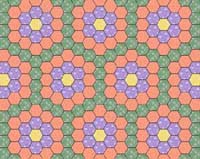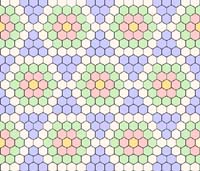Grandmother's Flower Garden: A Most Popular Quilt Pattern
"Listen in on any group of ardent quilt fans and you will hear frequent mention of this most popular pattern of the day and it is not hard to see why." 1
Romance of the Patchwork Quilt - 1935
Barbara Brackman reports that the Grandmother's Flower Garden was the most popular pattern after 1925. She tells us, "...many women who never made another quilt finished a Grandmother's Flower Garden." 2

The writer quoted above gives the names Grandmother's Flower Garden and French Bouquet for this pattern. She goes on to say that "modern" quilters loved the endless color combinations and ways the blocks could be set together with this pattern. She relates, "Another matter of pride is the number of small hexagons in the finished quilt, often many thousands." Although many Grandmother's Flower Garden quilts do not contain many thousands of hexagons they still represent a great deal of labor.
This lovely mosaic quilt may have been truest to the Colonial Revival's ideal of reproducing early American quilts, for the mosaic quilt was indeed made as early as the end of the 1700s. Early names for this quilt were honeycomb and mosaic.

Early hexagon quilts were usually made using the English Paper Piecing method. It is quite different from modern paper piecing and is a method done by hand, not machine. Many modern quilters are finding they like this old method and it is a good way to accurately put together a Grandmother's Flower Garden Quilt. Excellent instructions can be found at Keeping Us in Stitches: English Paper Piecing.
By the early 1900s many quilt makers were simply sewing the seams together much like they would piece anything else. I'm not going to give instructions here as there are detailed instructions on Marcia Hohns' wonderful site, The Quilter's Cache, at Grandmother's Flower Garden. Be sure to honor her terms of use.

The most common way Grandmother's Flower Garden quilts were made was with a central hexagon and rows of hexagons surrounding it with an interconnecting row of white or in some cases green for grass as in the picture above to the right. But quilters are always creative and variations were used like the quilt to the left that surrounds the flower with an interconnected star.
The size of the hexagon used can be varied as well. Earlier quilts tended to use hexagons an inch or less across while 20th century hexagons tended to be larger. Go to the Flower Garden Hexagon Pattern Template and print it out. You may find you want yours to be a different size. Enlarge or reduce it then add a 1/4 inch seam.
If you elect to follow the hexagon edges it could be done using bias binding. You can either use commercial bias tape as many did in the 1900s or you can make your own bias strips. Another method would be with a pillowcase turn. Recently I saw an exquisite Flower Garden Quilt that was done with a knife edge. The edges were turned under toward the batting and were carefully whipstitched together.
 Many Grandmother's Flower Garden quilts were finished along the edges of each hexagon or the hexagons trimmed like the binding pictured to the right. Others were finished with a straight border. Quilt historian, Charlotte Bull, tells about a lovely quilt finished like this. In this case a wide border was cut then the edges of the hexagon quilt were appliqued onto it. This left a nice area around the Grandmother's Flower Garden where the quilter added fancy cable & feather plume quilting. Another possibility would be to applique flowers on the border.
Many Grandmother's Flower Garden quilts were finished along the edges of each hexagon or the hexagons trimmed like the binding pictured to the right. Others were finished with a straight border. Quilt historian, Charlotte Bull, tells about a lovely quilt finished like this. In this case a wide border was cut then the edges of the hexagon quilt were appliqued onto it. This left a nice area around the Grandmother's Flower Garden where the quilter added fancy cable & feather plume quilting. Another possibility would be to applique flowers on the border.
So hexagon edging or a straight border the choice is yours. Either way would be true to the period.
� 2007 Judy Anne Breneman
print a printer friendly version of this pageLearn about the history of hexagon quilts
Honeycomb to Grandmother's Flower Garden
1 p 88 "The Romance of the Patchwork Quilt" by Carrie A. Hall & Rose G. Kretsinger
2 p 169 "Clues in the Calico" by Barbara Brackman





